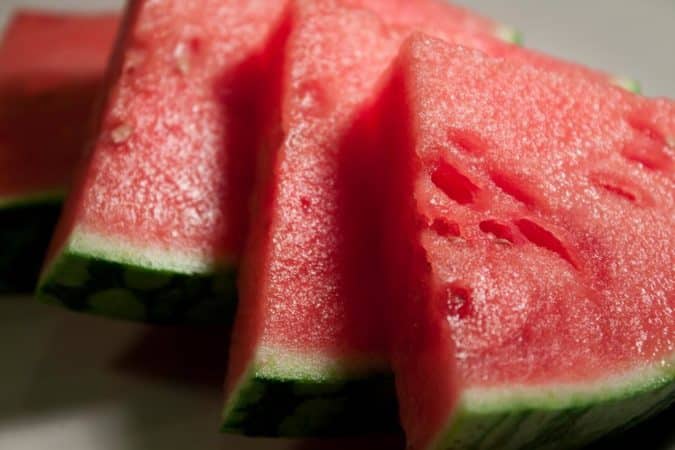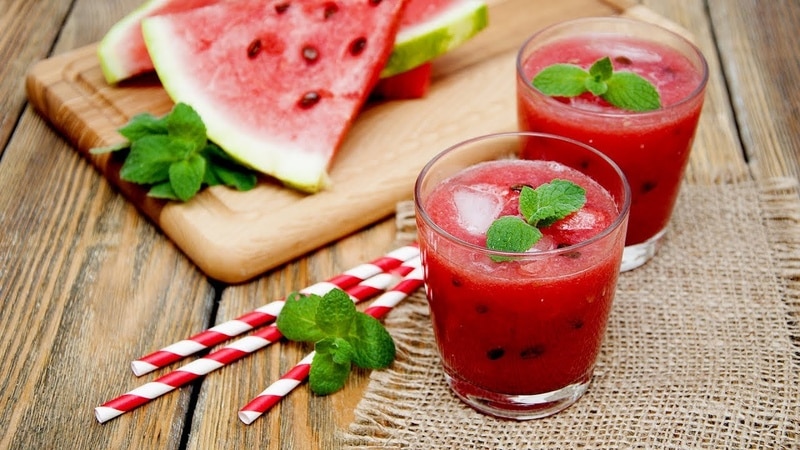Is it possible or not to drink watermelon for pancreatitis: norms and rules of use, contraindications
Pancreatitis is a disease of the pancreas, in which a strict diet is introduced, limiting the consumption of foods with fats and carbohydrates. In this regard, questions arise regarding the advisability of eating watermelons for various types of pathology and at the stage of remission. Is it possible or not to eat watermelon for pancreatitis - read the article.
Is it possible to eat watermelon if you have pancreatitis?
Watermelon has a rich chemical composition, which determines its wide healing properties and high benefits for the human body.
According to traditional medicine recipes, it is recommended to use it for many different diseases. AND pancreatitis not an exception.
Points for and against

The first argument in favor of using melons for pancreatitis is that it consists of 92% water. Also, watermelon is completely free of fats and proteins that can harm the pancreas. At the same time, the berry is rich in simple carbohydrates: glucose and sugar. The pulp also contains pectin, and this can negatively affect an unhealthy organ.
In case of chronic inflammation, the choleretic properties of the sweet berry will provoke a relapse of the disease. Watermelon also causes colic, fermentation in the intestines and swelling. However, the berry contains a high content vitamins and microelements. Folic acid is considered an indispensable activator of proper digestion.
Important! The antioxidants that melons are rich in have an anti-inflammatory effect on the body.
Chemical composition
Watermelon is a herbaceous annual plant of the pumpkin family, which, according to culinary classification, is considered a fruit.
The amount of useful components filling its pulp brings melons to a leading position among food products approved for consumption for pancreatitis. Its chemical composition is represented by vitamins and minerals.
Vitamins that watermelons are rich in:
- B9 – 3 mcg;
- B4 – 4.1 mg;
- A – 28.0 µg;
- E – 0.1 mg;
- C – 8.1 mg.
Minerals:
- iron – 0.2 mg;
- sodium – 1 mg;
- calcium – 7 mg;
- phosphorus – 11 mg;
- magnesium – 10 mg;
- potassium – 112 mg.
KBZHU
The ratio of calories, fats, proteins and carbohydrates per 100 g of product:
- calories – 30 kcal,
- proteins – 0.6 g,
- fats – 0.1 g,
- carbohydrates – 5.8 g.
The benefits and harms of watermelon for illness
Eating aromatic and juicy berries for inflammation of the pancreas is allowed when the disease is in remission. This is due to a number of positive properties of the product. Thus, watermelon acts as an element of dietary nutrition due to its low calorie content.
Antioxidants in its composition effectively fight free radicals, cleansing the body, and folic acid enhances protein processing and takes part in the process of cell division.
Reference. Thanks to magnesium and potassium, watermelon improves the functioning of the neuromuscular system and regulates heart rate.
If sweet berries are consumed during an exacerbation of pancreatitis, irreparable harm will be caused to the body. A single dose in large quantities will cause an increase in the load on the pancreas. Increased peristalsis is fraught with stagnation of pancreatic secretions and the development of pancreatic necrosis. Uncontrolled consumption of watermelon will cause nausea, diarrhea, colic and flatulence.
Watermelon during exacerbation of pancreatitis
During an exacerbation of the disease, it is forbidden to eat any fruits, vegetables and berries raw. And melon culture is no exception. This is done to reduce the load on the gastrointestinal tract.
In chronic form
Doctors allow the use of watermelon for chronic pancreatitis, but only during remission, when there are no symptoms. It is allowed to eat the pulp of the berry boiled, as part of salads, compotes and juices, or even raw. At this time, watermelon will not only not provoke increased secretion of pancreatic juice, but will also have a positive effect on the entire body.
Attention! The product consumed must be at room temperature.
Rules for use for pancreatitis
Eating watermelon pulp starts with 1 tbsp. l. per day, gradually increasing the daily norm to 200 g.
In the absence of a negative reaction from the body, the dose is increased to 1-1.5 kg. Eating salted or pickled berries is strictly prohibited.
In what form is it better to eat watermelon for pancreatitis?
A person will benefit from consuming the pumpkin family only if the fruit is natural and of high quality. When purchasing, it is recommended to find out where the product was grown, because watermelon tends to accumulate harmful substances and toxins.

People with pancreatitis are allowed to eat:
- fresh berries from the garden;
- salads;
- mousses;
- candied fruit;
- jam;
- juices
Several suitable recipes
To prepare a refreshing natural juice, choose a ripe fruit without visible defects.Then they wash it, cut it and remove the pulp, clearing it of seeds.
The best option for separating the liquid is a juicer. In its absence, the pulp is crushed with a blender and filtered through cheesecloth. It is acceptable to mix the finished product with apple, currant or pumpkin juice.
Important! It is recommended to drink the prepared watermelon drink throughout the day, without placing it in the refrigerator.
To prepare the mousse you will need 800 g of seedless watermelon pulp, 10 g of gelatin and 80 g of sugar. Gelatin is diluted with warm water and left to swell for 15 minutes. At this time, the watermelon is pureed with sugar, brought to a boil, the prepared gelatin is poured in and mixed. After cooling, beat until foamy. The dish is ready.
Watermelon honey is prepared from the pulp of 3 ripe large berries. The juice is first squeezed out and boiled on the stove for about 4 minutes. The cooled liquid is cleared of remaining fibers by straining through thick gauze and boiled over low heat until thickened (about 3.5 hours). During the cooking process, the product is stirred and the foam is removed from it. The finished honey is poured into sterilized jars. No sugar needed.
Contraindications
The use of melons is strictly contraindicated at the stage of disease progression.
Eating watermelon is prohibited if you have the following symptoms:
- nausea;
- vomit;
- diarrhea;
- pain in the abdomen or stomach;
- flatulence;
- colic;
- bloating.
Precautionary measures
To accelerate the ripening of early watermelons, fertilizers are used, which can be hazardous to health, especially with pancreatitis.
According to experts, in watermelon grown with the use of chemicals, a large number of yellow veins are visible in the pulp.The rich red color also indicates that ripening has been artificially accelerated.
The ideal fetal size is limited to 5 kg. Large berries indicate the use of growth stimulants, and small ones indicate a lack of nutritional components. A ripe product makes a dull sound when tapped, and a cracking sound when pressed.
This is interesting:
Is watermelon good for the liver and can it be eaten if you have liver diseases?
Watermelon for gallstones: can you eat it and in what quantities?
How to eat watermelon for cystitis: how much you can eat during the day
Conclusion
When pancreatic disease is in remission, watermelon is consumed with caution, since chronic pancreatitis causes more severe pathologies to develop: diabetes mellitus, narrowing of the duodenum, ulcers, gastritis, cholecystitis, etc.